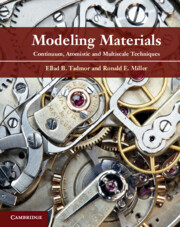Book contents
- Frontmatter
- Contents
- Preface
- Acknowledgments
- Notation
- 1 Introduction
- Part I Continuum mechanics and thermodynamics
- Part II Atomistics
- 3 Lattices and crystal structures
- 4 Quantum mechanics of materials
- 5 Empirical atomistic models of materials
- 6 Molecular statics
- Part III Atomistic foundations of continuum concepts
- Part IV Multiscale methods
- Appendix A Mathematical representation of interatomic potentials
- References
- Index
5 - Empirical atomistic models of materials
from Part II - Atomistics
Published online by Cambridge University Press: 05 June 2012
- Frontmatter
- Contents
- Preface
- Acknowledgments
- Notation
- 1 Introduction
- Part I Continuum mechanics and thermodynamics
- Part II Atomistics
- 3 Lattices and crystal structures
- 4 Quantum mechanics of materials
- 5 Empirical atomistic models of materials
- 6 Molecular statics
- Part III Atomistic foundations of continuum concepts
- Part IV Multiscale methods
- Appendix A Mathematical representation of interatomic potentials
- References
- Index
Summary
In the previous chapter, we saw the enormous complexity that governs the bonding of solids. Electronic interactions and structure in the presence of the positively charged ionic cores can only be fully understood using the machinery of Schrödinger's equation and quantum mechanics. But the simplest of bonding problems, that of two hydrogen atoms, is already too complex to solve exactly. Density functional theory (DFT), whereby Schrödinger's equation is recast in a form amenable to numerical solution, provides us with a powerful tool for accurately solving complex bonding problems, but at the expense of significant computational effort. Tight-binding (TB) reduces the burden by parameterizingmany of the integrals in DFT into simple analytic forms, but still requires expensive matrix inversion. To have any hope of modeling the complex deformation problems of interest to us (see, for example, Chapter 6), we must rely on much more approximate approaches for describing the atomic interactions using fitted functional forms.
As we saw in Section 4.5, the TB formulation provides a bridge between DFT and empirical potentials. However, given the boldness of some of the approximations that take us from full quantum mechanics to TB, one might question why empirical models should work at all. It is true that we must view all empirical results suspiciously. In some cases they can be quite accurate, while in others we may only be able to use them as idealized models that capture the general trends or basic mechanisms of the real systems.
- Type
- Chapter
- Information
- Modeling MaterialsContinuum, Atomistic and Multiscale Techniques, pp. 237 - 303Publisher: Cambridge University PressPrint publication year: 2011



